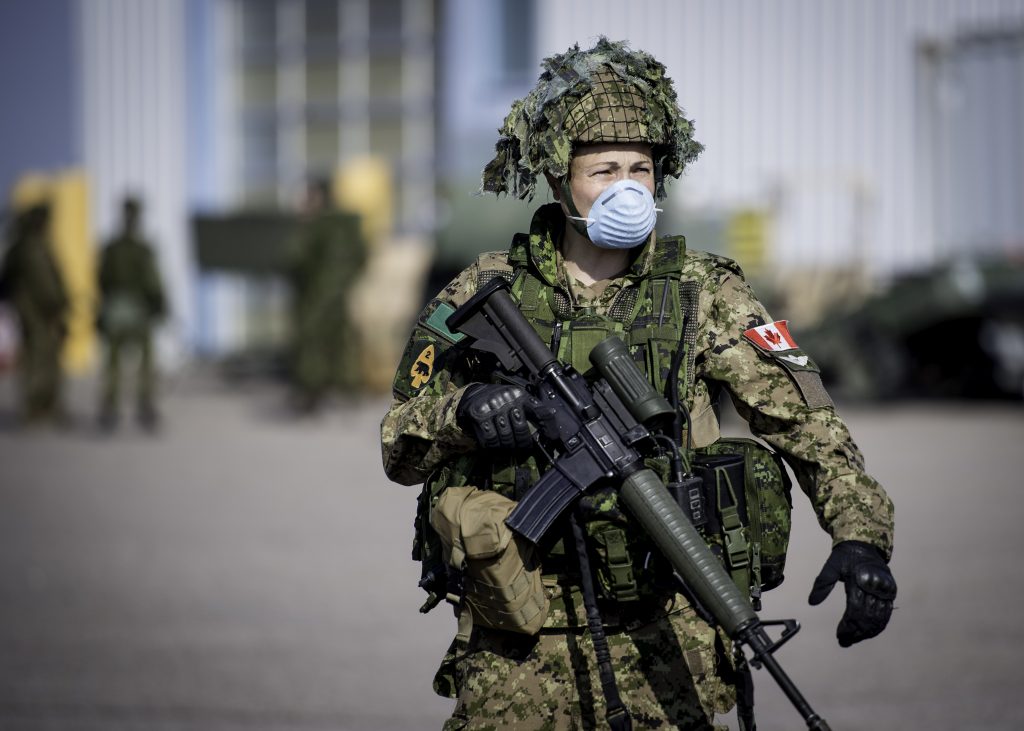This blog post is written as part of the Virtual Workshop Cycle on Building Capacity in the Age of COVID-19. The third workshop, which took place on November 3rd, 2020 focused on peacekeeping and involved Marie-Joelle Zahar, professor at the University of Montreal, Cedric de Coning, professor at the Norwegian Institute of International Affairs, Arthur Boutellis, advisor at the International Peace Institute and Mody Berethe, director of the Bamako Peacekeeping School. The information reported in the text is a general synthesis of the ideas presented by the speakers.[1]
How has the ongoing COVID-19 pandemic influenced capacity building in peacekeeping? Answering this question seems to require a preliminary review of the changes in the UN’s engagement in conflict zones in the years preceding the health crisis. Whether in Mali, the Central African Republic or the Democratic Republic of the Congo, peace operations since the end of the Cold War have gradually been reoriented towards the management of multi-party internal conflicts, gradually moving away from the objectives that had previously prevailed in the resolution of often binary state conflicts. In the absence of peace agreements and sufficient material resources to deal with unpredictable security situations, the primary objective of these new stabilization operations today is mainly to protect the civilian populations, by preventing the mutation of complex socio-political situations in high intensity civil wars.
In this context of new operations – which are often thought of in a more offensive way – UN capacity-building activities have changed in recent years. In a positive way, the need to devote significant human and material resources to the continuous capacity-building of UN personnel intervening in conflict zones is now fully recognized. On the military level, training for troops operating in UN peace operations is carried out regularly during their field deployments. The goal is often to adapt units formed in heterogeneous national settings to qualitatively different operations that are conducted in conjunction with other armies. More and more training focuses, for example, on key sectors such as the evacuation of injured personnel, the management of improvised explosive devices or the protection of civilian populations, which is understood more broadly. At the civilian level, to a lesser extent, training within peace operations has also been gradually implemented, with the aim of raising civilian stakeholders’ awareness of the central issues surrounding peacekeeping and, with a view to longer term, conflict resolution.
In general, the planning of peace operations has received increased attention in recent years, with the aim of better coordinating the actions of the countries funding operations and the countries mainly engaged by sending troops to theatres of conflict. Major advances have also been made in the performance evaluation of various UN operations with the objective, for the organizations involved, of ensuring that the programs meet predefined efficiency criteria. In addition, one of the important advances is the growing cooperation of the United Nations with regional organizations – foremost among them the African Union – which, by promoting greater local ownership, undeniably contributes to strengthening the legitimacy of peace operations.
All the same, while progress has undoubtedly been made, structural problems remain concerning the functioning of peace operations, with a direct impact on the effectiveness of capacity-building in this area. The frequently highlighted division between northern countries providing funding for peace operations and southern countries providing troops remains a central element in the sharing of responsibilities for peacekeeping, and continues to define an inevitably unbalanced model. The peace operations agenda remains determined by the strategic and operational priorities of the funding countries (supply-driven), to the detriment of the predictive capacities of operations on deployment sites. In the area of capacity-building, large-scale UN training – necessarily costly – remains the exception and suffers from a lack of institutionalization. If improved, the capacity to assess the success of operations can also be further refined and adapted to unique and changing socio-political contexts. Moreover, if the civilian dimensions are increasingly recognized as central, many current operations remain mainly centered around short-term security issues, and find it difficult to imagine the construction of peace in a longer political time within the conflicting spaces.
It is in this ambiguous context – both undeniable progress and persistent challenges – that the health crisis linked to COVID-19 takes place. On the one hand, affecting countries in political crises as well as funding and troop-contributing countries, the pandemic was recognized very early as a salient issue by the UN. Already faced with several cases of major health crises – foremost among which are the cholera-related crises in Haiti as well as the management of the Ebola epidemic in the Democratic Republic of the Congo – peace operations quickly put in place the measures and health facilities necessary to mitigate the effect of the pandemic on their daily activities. Some military rotations have been suspended and many UN civilian personnel have started working from home, but the main tasks of the organization have, on the whole, been maintained. On the other hand, while the pandemic does not bring qualitatively new peacekeeping issues to the agenda, it seems to increase the salience of pre-existing tensions and debates.[2] The health crisis once again underlines the limits of an international intervention system whose operational agenda is entirely defined by the main funders. While the political and economic systems of these donors are largely impacted by the pandemic, the risk is that they will quickly decide to limit their investments to daily operations deemed strictly essential – often immediate operational security actions – to the detriment of long-term operations; for example the building of strong and inclusive political institutions in the countries of intervention. In this context, capacity-building operations risk being sacrificed as a priority.
Finally, while it undeniably reinforces the centrality of pre-existing problems, the pandemic also marks a pivotal period that may, by necessity, become synonymous with incremental improvements in peace operations. The already anticipated withdrawal of certain international actors in conflict zones may, for example, be an opportunity to give more space to local peacekeeping initiatives. The shutdown of certain training programs can, in the same way, become an unprecedented opportunity to rethink them in a creative way to adapt them to changing contexts. This is especially the case in the Sahel, where political, social and security crises cannot be considered in isolation. Emphasizing the training of senior officers within the military and police hierarchies in particular can be used to better structure operations in general. UN peace operations can also be reconceptualized as a tool that can indirectly serve troop-contributing countries, through the training of their armies and police in contexts different from those they know within their national frameworks. By emphasizing issues related to respect for human rights, conflict prevention rather than their sole resolutions and the development of peaceful relations between civil and military authorities, these trainings could also strengthen a “culture of peace” beyond the sole areas of intervention of the UN.
As the risks of social crises are aggravated by the pandemic and the gravity of its economic repercussions, reconsidering the way in which UN peace operations can be spaces for the transmission of knowledge and good practices seems necessary. Soon, the central question will be: how, from the crisis, can a UN intervention model be created that is more in line with contemporary constraints and issues?
[1] However, the ideas presented are those of the author.
[2] As previously demonstrated in the case of counterinsurgency and counterterrorism.





Comments are closed.